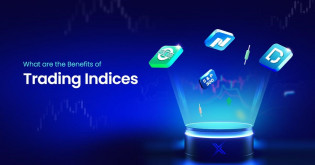-
AI (artificial Intelligence) is changing many sectors, from healthcare and banking to manufacturing and communications. As industries evolve, investors are following and are increasingly interested in investing in AI stocks. But there is more than one way to invest - trading AI stocks via Contracts for Difference (CFDs) is gathering pace. CFD trading allows you to speculate on the price movement of an underlying stock, without owning the stock itself. In this blog, we will simplify everything you need to know about what is CFD trading, how to invest in AI stocks, and how to trade them with CFDs in a formal, detailed, but easy-to-understand manner.
What Are AI Stocks?
"AI stocks" are the shares of companies that functionally develop or use artificial intelligence technologies. This could mean the big names in tech like Alphabet (Google), Microsoft, and Nvidia, or niche players focused on machine learning, robotics, or data analytics. With a global AI market projected to reach trillions in the next ten years, AI stocks are an exciting opportunity for both long-term and short-term investors.
What Is AI Stock CFDs?
CFDs, or Contracts for Difference, are financial derivatives that allow traders to speculate on the price direction of various assets, such as AI stocks, without owning the underlying asset. When you enter a trade index CFD on AI stock, you are going into a contract with a broker who agrees to trade in the difference between the starting value of the asset and the closing value of the trade.
A flexible method of exposure to the fast-growing AI industry is presented by AI stock CFDs. They allow making of both short (sell) and long positions (buy), which enables you to make a profit at both times, in the rising and falling markets.
Why Invest in AI Stocks?
The AI stocks have been pitched along the lines of their incredible growth potential. Because more innovations and disruptions in the industries due to AI are going to occur, the companies that become the pioneers of such changes are likely to experience more demand for their products and services. An example is Nvidia, which manufactures GPUs to support AI models, and Alphabet, which integrates AI into its search and cloud products. Long-term opportunities are that the market for AI will be worth 2.5 trillion dollars by 2032. Moreover, AI stocks give a chance of diversification because they exist in numerous sectors. Naturally, AI stocks, like any other investment property, may be risky in a few ways, such as fluctuations within the market and possible regulatory barriers.
Benefits of CFD Trading for AI Stocks
There are many benefits of CFD trading first, trading with leverage allows you to have greater exposure in the market with less of your capital, making it more accessible for investors with smaller trading accounts. Second, you can profit in rising markets (long) and falling markets (short), giving you more opportunities to trade. Third, using CFDs gives traders access to hundreds of AI stocks and stock market indices, and indices for a wider variety of short selling, long positions, and capitalizing on considerable returns when trading AI stocks.
There are usually lower transaction costs for trading CFD stocks than traditional stock investing, to be clear. However, as the name suggests, the greater the leverage also means greater the risk, and you should implement suitable risk management techniques in your trading to protect your trading capital.
How to Invest in AI Stocks with CFDs
Trading AI stock CFDs can be simple if done with proper planning and risk consideration. Follow the steps below to trade CFD indices:
- Choose a Reputable CFD Broker: This is the crucial first step; look for a broker that is regulated and offers AI stock CFD instruments with competitive spreads and reputable trading platforms and customer support. Having a demo account is a plus, allowing you to engage in trading without risking real money. CapitalXtend is one such platform that provides access to a vast range of CFDs, including AI stock-related ones.
- Understand CFD Trading Fundamentals: Before you consider entering a trade on the markets for the first time, make sure that you understand the concept of CFD trading. This means understanding what leverage, margin, spreads, and overnight financing charges are. Leverage might increase your power to make profits; however, it can equally increase the scale of your losses.
- Research AI Stocks: Avoid jumping into trading blindly; research is crucial. Choose AI companies that resonate with your investment thesis. Include considerations for:
- Innovation and Technology: How does AI technology fit in their core business (e.g., machine learning, natural language processing, computer vision, robotics); how advanced is their R&D?
- Market Position: Are they the leaders or some emerging player with high growth in their niche?
- Financial Health: Examine their revenue growth, profitability measures, balance sheet, and cash flow.
- Competitive Landscape: Name their competitors and what makes them different from others.
- News and Developments: Monitor news about the company, trends in their sector, and changes in regulations affecting the AI area.
- Develop a Trading Strategy: A good trading plan plays a key role in success. This entails calculating your point of entry, exit, risk management setting (stop-loss and take-profit level), and general trading strategy. In the following section, we will discuss CFD trading options applied to AI stocks.
- Practice with a Demo Account: Most of the professional CFD brokers provide Demo accounts. This will help you to test your strategies, make yourself acquainted with the trading platform, and help you become confident without losing real money. This is most critical to new traders or new converts to CFD trading.
- Fund Your Live Account and Start Trading: When you feel confident and comfortable, you can deposit into your live account and begin trading. Begin with small position sizes and later increase them as you acquire experience and expertise. Never fail to follow your risk management plan.
CFD Trading Strategies for AI Stocks
To succeed in CFD trading, you need a well-defined strategy. Here are three effective strategies for trading AI stocks:
1. Trend Following
It consists of spotting where the trend is and placing trades accordingly. If, just as with Nvidia shares, the trend is up due to booming demand for AI, then you buy CFDs. With the help of moving averages or Average Directional Index (ADI), one can confirm the trends. This kind of trading works best in highly volatile markets, but it requires a lot of discipline to refuse chasing false breakouts.
2. Breakout Trading
Moving into a trade when the stock price forces its way through a key support or resistance level is what breakout trading entails. For example, post the launch of an AI product, Microsoft stock might have broken above its resistance level; one could have bought its CFDs for the expectation of further gains. Confirm breakouts using volume indicators and keep tight stop-losses for risk management.
3. Sentiment Analysis
Stocks in AI are also very much affected by the mood in the market, which is caused by news, social media, and earnings reports. Determine how investors feel about companies such as Alphabet or Tesla through sentiment analysis tools. Providing good news concerning developments of AI increases sentiment, and in that case, you may consider entering long positions in relative CFDs. On the other hand, a short position might be triggered by a negative sentiment.
Every strategy suggests a close examination and risk mitigation to be able to move in the AI market that is driven fast.
Best AI Stocks to Trade as CFDs
The world of AI is dynamic, and new players come to the market, and some old technological giants invest more in ML. Going to the question of the most promising AI stocks to trade as CFDs, it is necessary to pay attention to companies that are leaders in the development of AI and currently have a good position in the market. Some of the prominent examples are as follows (this is not financial advice, and the situation might change greatly within the market):
• Nvidia (NVDA): Top supplier of Graphics Processing Units, critical components in AI calculations.
• Alphabet (GOOGL): AI development and heavy research are conducted by DeepMind and Google AI.
• Microsoft (MSFT): Provides AI tools via Azure and has investments in OpenAI.
• Amazon (AMZN): Good AI footprint through AWS and Alexa.
• Palantir Technologies (PLTR): A company that works with AI analytics in big data.
They are commonly traded in the big stock market indexes, making them accessible on most CFD trading platforms.
Risks of Trading AI Stock CFDs
Despite the available opportunities in the use of CFDs as a medium of trade, trading in CFDs involves a great portion of risk. You can magnify your losses, which can be bigger than the initial capital. AI stocks will constantly swing due to the instability caused in the market by the ever-changing technology and regulatory environment. To illustrate it, new regulations on AI stocks (or generally on any asset) may change overnight. Also, contracts-for-difference (CFDs) that display that you are in a position overnight will attract an overnight cost that may be expensive. To limit risks, you can: use stop-loss orders, limit leverage, diversify your stock market index, or other asset portfolios. To succeed in CFD trading, it is necessary to stay disciplined and ensure that your body of knowledge is updated.
Conclusion
Trading in the stocks of AI and making use of CFDs is a thrilling way to invest in the artificial intelligence revolution that is taking place. To jump over to this new market, you must be aware of the industry, select the apt stocks to trade in, and possess exemplary CFD trading plans. It is a tremendous opportunity, and this is still very risky due to the leverage and chaos of the marketplace. What matters is that you have a plan and that you discipline yourself, whether your plans involve making long-term investments or short-term trading. And keep yourself informed about news in your investing industry and employ a few nice risk management tricks. Contact us today, at CapitalXtend, to learn how to begin trading AI stocks and CFDs with us.
FAQs
1. What is CFD trading?
CFD trading entails the speculation of price movements of an asset, like stocks or indices, without owning a position in them. You earn profits with price changes, whilst leverage can be used to increase exposure.
2. Are AI stock CFDs suitable for beginners?
Yes-but beginners should begin with a demo account, apply low leverage, and understand risk management in order to limit their damage.
3. What are the benefits of CFD trading for AI stocks?
CFD trading offers leverage, the opportunity to profit in rising or falling markets, and lower transaction costs compared to traditional investing.
4. Which AI stocks are best for CFD trading?
Due to volatility and trading volume, attractive stocks like Nvidia, Microsoft, and Alphabet are considered some of the best for CFD trading.
5. How can I manage risks when trading AI stock CFDs?
Use stop-loss orders, limit the leverage, diversify your trades, and always stay up to date with market movements.
6. Can I trade AI stocks through indices?
Yes, trading CFDs of an index like the Nasdaq 100 will provide exposure to several AI-related companies, thus lowering the risk of any single stock.




